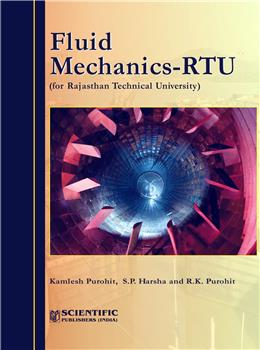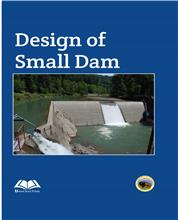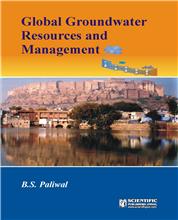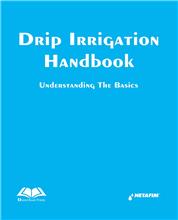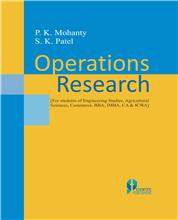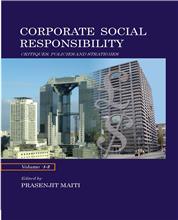1. BASIC CONCEPT RELATING TO FLUIDS
1.1 Introduction
1.2 Definition of a Fluid
1.3 Fluid as a Continuum
1.4 Incompressible and Compressible Flow
1.5 Basic Definitions
1.5.1 Mass
1.5.2 Density
1.5.3 Specific Volume
1.5.4 Specific Weight
1.5.5 Relative density
1.6 Viscosity
1.6.1 Units of Viscosity
1.6.2 Dimensional Formula of Viscosity
1.6.3 Kinematic Viscosity
1.6.4 Units of Kinematic viscosity
1.6.5 Dimensional formula of kinematic viscosity
1.6.6 Newtonian and non Newtonian fluids
1.6.7 Effects of temperature and pressure on viscosity
1.6.8 Ideal Fluid
1.7 Compressibility and Elasticity of Fluids
1.8 Surface Tension
1.9 Capillarity
1.10 Pressure inside a Water Droplet, Soap and Bubble
Illustrative Examples
EXERCISES
A. Theory
B. Unsolved problems
2. STATIC PRESSURE AND ITS MEASUREMENT
2.1 Introduction
2.2 Pressure at a Point
2.3 Pascal's Law
2.4 Euler's Differential Equations
2.4.1 The basic equation of hydrostatics
2.4.2 Pressure head
2.4.3 The hydrostatic paradox
2.5 Atmospheric Pressure
2.5.1 Fortin barometer
2.6 Application of the Basic Equation of Fluid Statics
2.7 Manometers
2.7.1 Piezometer
2.7.2 Simple manometers
2.7.3 Differential Manometers
2.8 Measurement of Small Pressure Difference
2.8.1 Inclined gauge
2.8.2 Micromanometers
2.9 Pressure Variation in a Compressible Fluid
2.9.1 Variation under Isothermal conditions
2.9.2 Variation under adiabatic conditions
2.9.3 Variation of pressure and density with altitude for a constant temperature gradient
2.9.4 Variation of temperature and pressure in the atmosphere
ILLUSTRATIVE EXAMPLES
EXERCISES
A. Theory
B. Unsolved Problems
3. FLUID STATICS
3.1 Introduction
3.2 Total Pressure
3.3 Centre of Pressure
3.4 Total Pressure and Centre of Pressure on A Vertical Plane Surface
3.5 Total Pressure and Centre of Pressure for Inclined Surface
3.6 Pressure Diagrams
3.7 Pressure on Curved Surfaces
3.7.1 General case of pressure on curved surfaces
3.7.2 Pressure on cylindrical surfaces
Illustrative Examples
EXERCISES
A. Theory
B. Unsolved Problems
4. BUOYANCY AND FLOATATION
4.1. Introduction
4.2. Buoyancy
4.3. Centre of Buoyancy
4.4. Equilibrium of Floating Bodies
4.5. Metacentre
4.6. Metacentric Height
4.7. Stability of Floating Bodies Metacentre and Metacentric Height
4.8 Experimental Method of Determination of Metacentric Height
4.9 Analytical Method for Metacentric Height
4.10 The Period of Roll of a Vessel
Illustrative Examples
Exercises
A. Theory
B. Unsolved problems
5. KINEMATICS OF FLUID
5.1 Introduction
5.2 Description of Fluid Motion
5.3 Fluid Flow Classifications
5.3.1 Steady flow and unsteady flow
5.3.2 Uniform flow and non uniform flow
5.3.3 One, two and three dimensional flow
5.3.4 Laminar flow and turbulent flow
5.3.5 Rotational flow and Irrotational flow
5.4 Flow Lines
5.4.1 Streamline
5.4.2 Stream tube
5.4.3 Path line
5.4.4 Streak line
5.5 Velocity and Acceleration
5.5.1 Convective acceleration and Local acceleration
5.5.2 Tangential acceleration and normal acceleration
5.6 Principle of Continuity Conservation of Mass Flow
5.6.1 One dimensional continuity equation
5.6.2 Continuity equation for three dimensional flow using Cartesian Coordinates
5.7 Deformation of a Fluid Element
5.8 Circulation and Vorticity
5.8.1 Circulation for the rectangular element
5.8.2 Circulation for the circle
5.8.3 Vorticity
5.9 Stream Function and Velocity Potential
5.9.1 The stream function
5.9.2 Velocity Potential
5.10 Flow Net
5.10.1 Methods of drawing flow nets
5.10.2 Uses of flow net
5.10.3 Limitations of flow net
ILLUSTRATIVE EXAMPLES
EXERCISES
A. Theory
B. Unsolved problems
6. DYNAMICS OF FLUID FLOW
6.1 Introduction
6.2 Euler's Equation of Motion
6.2.1 Bernoull's equation Integration of Euler's equation along a streamline for steady flow
6.2.2 Limitations on Bernoulli's equations
6.2.3 Modification to Bernoulli's equation
6.2.4 The physical significance of Bernoulli's equation
6.3 Applications of Bernoulli's Equation
6.3.1 Venturimeter
6.3.1.1 Venturimeter analysis
6.3.1.2 Vertical/Inclined Venturimeter
6.3.1.3 Use of differential manometer in venturimeter
6.3.2 Orifice meter
6.3.3 Flow nozzle or Nozzle meter
6.3.4. Flow tubes
6.3.5 Pressure recovery
6.4 Velocity Measurements
6.4.1 Static, stangnation and dynamic pressures
6.4.2 Pitot tube
6.4.3 Pitot static tube
6.5 Momentum Equation
6.5.1 Impulse-Momentum equation
6.5.2 Momentum equation for two and there dimensional flow along a stream line
6.5.3 Momentum correction factor
6.5.4 Application of the momentum equation
6.5.4.1 Forces on a pipe bend
6.5.4.2 Force due to the diflection of a jet by a curved vane
6.5.4.3 Force at a nozzle
6.5.4.4 Reaction of a jet
6.6 Navier Stokes Equations
6.2.1 Navier Stokes equation in vector form and meaning of each term
6.2.2 Navier Stokes in cylindrical polar coordinates
Illustrative Examples
EXERCISES
A. Theory
B. Unsolved Problems
7. FLOW THROUGH ORIFICES AND MOUTH PIECES
7.1 Introduction
7.2 Sharp Edged Orifice Discharging Free
7.3 Hydraulic Coefficients
7.3.1 Coefficient of contraction (Cc)
7.3.2 Coefficient of velocity (Cv)
7.3.3 Coefficient of discharge (Cd)
7.3.4 Coefficient of resistance (Cr)
7.4 Experimental Determination of Hydraulic Coefficients for an Orifice
7.4.1 Experimental determination of coefficient of contraction
7.4.2 Determination of coefficient of velocity Cv
7.4.2.1. Jet distance measurement method (Trajectory method)
7.4.3 Determination of coefficient of discharge
7.5 Submerged Orifice
7.6 Partially Submerged Orifice
7.7 Sharp Edged Large Vertical Orifice with Rectangular Shape
7.8 Mouthpieces or Tubes
7.8.1 External cylindrical mouthpiece running full
7.8.2 Flow through convergent divergent mouthpiece
7.8.3 Borda's or Re entrant mouthpiece
7.8.3.1 Borda's mouthpiece running free
7.8.3.2 Borda's mouthpiece running full
7.9 Flow through an Orifice or a Mouthpiece under variable heads
7.9.1 General procedure for calculating time of emptying a tank through an orifice /mouthpiece at its bottom
7.9.2 Time of emptying cylindrical tank
7.9.3 Determine the constant head under a head falling
7.10 Time of Emptying (or Filling) A Tank with Inflow
7.11 Flow of Liquid from One Vessel to Another
Illustrative Examples
EXERCISES
A. Theory
B. Unsolved problems
8. FLOW OVER NOTCHES AND WEIRS
8.1 Introduction
8.2 Rectangular Weirs
8.2.1 Flow over rectangular weir
8.2.2 Flow over rectangular weir with velocity of approach
8.2.3 Empirical formulae for discharge over rectangular weir
8.3 Flow over a Triangular Weir (V Notch)
8.4 Flow over a Trapezoidal Weir or Notch
8.4.1 Cippoletti weir
8.5 Long Based Weirs
8.5.1 Broad crested weir
8.5.2 Round nosed weirs
8.5.3 Crump weirs
8.6 Submerged Weirs
8.7 Ventilation of Weir
Illustrative Examples
EXERCISES
A. Theory
B. Unsolved problems
9. FLOW THROUGH PIPES
9.1 Introduction
9.2 Reynolds Experiments
9.2.1 Reynolds number and its Significance
9.2.2 Laminar and turbulent flow
9.2.3 Critical Reynolds number
9.3 Fluid Friction
9.4 Head Lost Due to Friction in Pipes Darcy's Weisbach Equation
9.4.1 Proof of the Darcy's Weisbach equation
9.4.2 Chezy's formula
9.4.3 Manning's formula
9.4.4 Hazen William's formula
9.5 Minor Losses
9.5.1 Head loss due to sudden enlargement
9.5.2 Head loss due to sudden contraction
9.5.3 Head loss at entrance to pipe
9.5.4 Exit loss
9.5.5 Head loss due to obstruction
9.5.6 Head loss due to bends, valves, Non symmetrical sections, etc.
9.6 Total Energy Line and Hydraulic Gradient
9.6.1 Total energy line (TEL)
9.6.2 Hydraulic gradient line (HGL)
9.7 Flow Through Pipe Lines
9.8 Flow through Pipes Connected in Series
9.9 Method of Equivalent Lengths
9.10 Flow through Pipes Connected in Parallel
9.11 Power Transmission through Pipes
9.11.1 Maximum power transmission efficiency
9.12 Flow through Nozzle at the End of a Pipe
9.12.1 Efficiency of Power transmission through nozzle
9.12.2 Condition for maximum power transmission through nozzle
9.12.3 Diameter of nozzle for maximum transmission of power through nozzle
9.13 Water Hammer
9.14 Water hammer analysis
9.14.1 Rigid Water Column theory
9.14.2 Elastic pipe theory
Illustrative examples
EXERCISES
A. Theory
B. Unsolved problems
10. LAMINAR VISCOUS FLOW
10.1 Introduction
10.2. Hagen-Poiseuille Flow
10.3. Plane Poiseuille Flow
10.4 Coutte Flow
Illustrative Examples
EXERCISES
A. Theory
B. Unsolved Problems
11 TURBULENT FLOW THROUGH PIPES
11.1 Introduction
11.2 Turbulent Shear Stress
11.3 Boussines Eddy Viscosity
11.4. Prandtl's Mixing Length Theory
11.5 Shear Velocity or Friction Velocity
11.6 Prandtl's Universal Velocity Distribution Equation for Turbulent Pipe Flow
11.7 Hydrodynamically Smooth and Rough Boundaries
11.8 Velocity Distribution for Turbulent Flow in Smooth and Rough Pipes Prandtl Karman Velocity Distribution Equation
11.8.1 Velocity distribution in smooth pipes
11.8.2 Velocity distribution in rough pipes
11.9 Velocity Distribution for Turbulent Flow in Terms of Average Velocity
11.9.1 Turbulent flow in smooth pipes
11.9.2 Turbulent flow in rough pipes
11.9.3 Difference between point velocity and average velocity for smooth and rough pipes
11.10 Turbulent Pipe Coefficient
11.11 The Chronological Development of Turbulent Pipe Flow Theories
11.11.1 Smooth pipes and Blasius equation
11.11.2 Stanton and Pannell
11.11.3 Nikuradse experimental results using artificially rough pipes
11.11.4 The smooth and rough laws of Prandtl and von Karman
11.10.5 The Colebrook White transition formula
11.11.6 Moody diagram for commercial pipes
11.11.7 Hydraulic Research station charts (HRS) Acketes
11.11.8 Barr explicit formula
11.11.9 Murdock formula
11.11.10 Swamee and Jain's explicit equation
11.11.11 S.E. Haaland's formula
11.12 Non Circular Pipes
11.13 Roughness of Pipes with Age (Old Pipes)
Illustrative Examples
Exercises
A. Theory
B. Unsolved Problems
12. DIMENSIONAL ANALYSIS AND SIMLITUDE
12.1 Introduction
12.2 Dimensions, Dimensional Homogeneity and Units
12.3 Dimensional Analysis
12.3.1 The Buckingham - theorem
12.3.2 Selection of repeating variables
12.3.3 Determining the groups
12.3.4 Some additional comments about dimensional analysis
12.3.5 Uniqueness of terms
12.3.6 Limitations of dimensional analysis selection of variables superfluous and omitted variables
12.4 Modeling and Similitude
12.4.1 Geometric Similarity
12.4.2 Kinematic similarity
12.4.3 Dynamic similarity
12.4.4 Standard dimensionless numbers
12.4.4.1 Reynold's number (Re)
12.4.4.2 Froude's number ( )
12.4.4.3 Mach's number (M)
12.4.4.4 Euler's number (Eu)
12.4.4.5 Weber's number (Wb)
12.5 Model Laws
12.5.1 Reynold's model law
12.5.2 Froude's model law
12.5.3 Mach model law
12.5.4 Euler's model law
12.5.5 Weber's model low
12.6 Undistorted and Distorted Models
12.7 Scale Effect
12.8 Comments on Model Testing
Illustrative Examples
EXERCISES
A. Theory
B. Unsolved problems
13. BOUNDARY LAYER THEORY
13.1 Introduction
13.2 Description of the Boundary Layer
13.3 Boundary Layer Thicknesses
13.3.1 Boundary layer thicknesses
13.3.2 Boundary layer displacement thickness
13.3.3 Momentum thickness
13.3.4 Energy thickness **
13.4 Local Skin Friction and Average Skin Friction Drag Coefficient
13.4.1 Local skin friction drag coefficient Cf
13.4.2 Average skin friction drag coefficient CD
13.5 The Prandtl Boundary Layer Equations
13.6 Blasius Solution
13.7 Momentum Integral Boundary Layer Equation for Flat Plate or VON Karman Integral Equation
13.7.1 Momentum integral equation for zero pressure gradient
13.8 Momentum Integral Method for Laminar Flow over a Flat Plate
13.9 Turbulent Boundary Layer
13.10 Combined Laminar and Turbulent Boundary Layers
13.11 Coefficient of Drag for Turbulent Boundary Layer for Rough Plate
13.12 Flow with a Pressure Gradient
13.13 Separation of Boundary Layer Flow
13.13.1 Examples of separation of boundary layer flow
13.13.2 Separation control
Illustrative Examples
EXERCISES
A. Theory
B. Unsolved Problems
14 FLOW OVER IMMERSED BODIES
14.1. Introduction
14.2 Forces on Immersed Bodies Drag and Lift
14.3 Drag on Immersed Bodies
14.4 Types of Drag
14.4.1 Skin friction drag
14.4.2 Pressure drag
14.4.3 Profile drag
14.4.4 Deformation drag
14.4.5 Wave drag
14.4.6 Induced drag
14.5 Streamlined and Bluff Bodies
14.6 Drag on Sphere
14.6.1 Dynamics of sports ball
14.7 Drag on Cylinder
14.7.1 von Karman vortex street
14.7.2 Summary of flow regimes in flow past a circular cylinder
14.8 Lift
14.8.1 Magus effect and the circulation theory of lift (Kutta Joukowski theorem)
14.9 Lift of an Aerofoil
14.10 Aerofoil Terminology
14.11 Inviscid Flow Past a Two Dimensional Aerofoil
14.12 Real (Viscous) Fluid Past A Two Dimensional Aerofoil
14.13 Aerofoil Characteristics
Illustrative Examples
EXERCISES
A. Theory
B. Unsolved Problems
